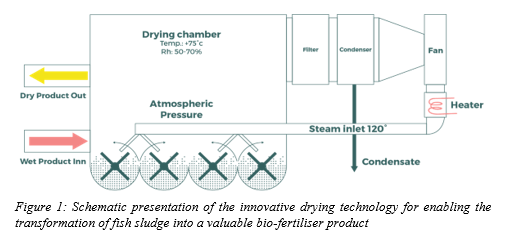FROM BLUE TO GREEN: TRANSFORMING FISH SLUDGE INTO A VALUABLE BIO-FERTILISER PRODUCT USING INNOVATIVE DRYING TECHNOLOGY
Introduction
The work on improved sustainability in the aquaculture industry by valorisation of side-streams being performed in the GAIN (Green Aquaculture INtensification in Europe) project has resulted in innovative machines in standardised sizes for processing of fish sludge at hatcheries. Initially, it proved challenging to achieve a stable process for fish sludge drying. However, through a number of improvements Waister has ensured a stable drying process with a predictable processing capacity.
GAIN is a Horizon 2020 project, delivering services and technologies to market within the project period to contribute to the ecointensification of European aquaculture production. Resource efficiency, reduced environmental impact, increased precision and valorisation throughout the production chain are all key elements in the approach to improve seafood self-proficiency and regional stability.
Achievements
Processed with the innovative technology, dried fish sludge from hatcheries has proved to be rich in nitrogen (N) and phosphorus (P), while relatively low on heavy metals. This allows the dried fish sludge, given the correct processing, to be utilised as a potentially valuable bio-fertiliser. By combining a mechanical fluidisation of the fish sludge in the drying chamber, inserting superheated steam with a relatively low temperature, Waister has achieved a significant decrease of N loss in the drying process. Through a number of innovations and improvements to the drying technology, Waister has achieved N levels as high as 7 % in the dried fish sludge.
There is no common EU classification standard of bio-fertiliser products from fish sludge. The Norwegian classification system defines four quality classes determined from the level of heavy metals in the bio-fertiliser product. The dried fish sludge from this innovative drying process produces a bio-fertiliser product in quality class I, which is the second best out of the four classes, allowing spread of up to 4 kg/m² over a period of ten years for use in agriculture, private gardens, and parks. Growth trials made on barley has shown up to 45 % better yield than the reference mineral fertiliser. The dried bio-fertiliser product is thereby proved as a well-functioning and safe product for application on lands for productions of both feedstock and crops for human consumption, thereby enabling a circular economy solution to an aquaculture challenge.
We will present the applicability of the dried fish sludge as a bio-fertiliser, as well as the standardised solutions for a stable technology on processing of transforming fish sludge into a valuable bio-fertiliser product.
Acknowledgements
The research leading to these results has also received funding from the GAIN project, European Union’s HORIZON 2020 Framework Programme under GRANT AGREEMENT NO. 773330.
This project has received funding from the European Union’s Horizon 2020 research and innovation programme under grant agreement N° 773330
